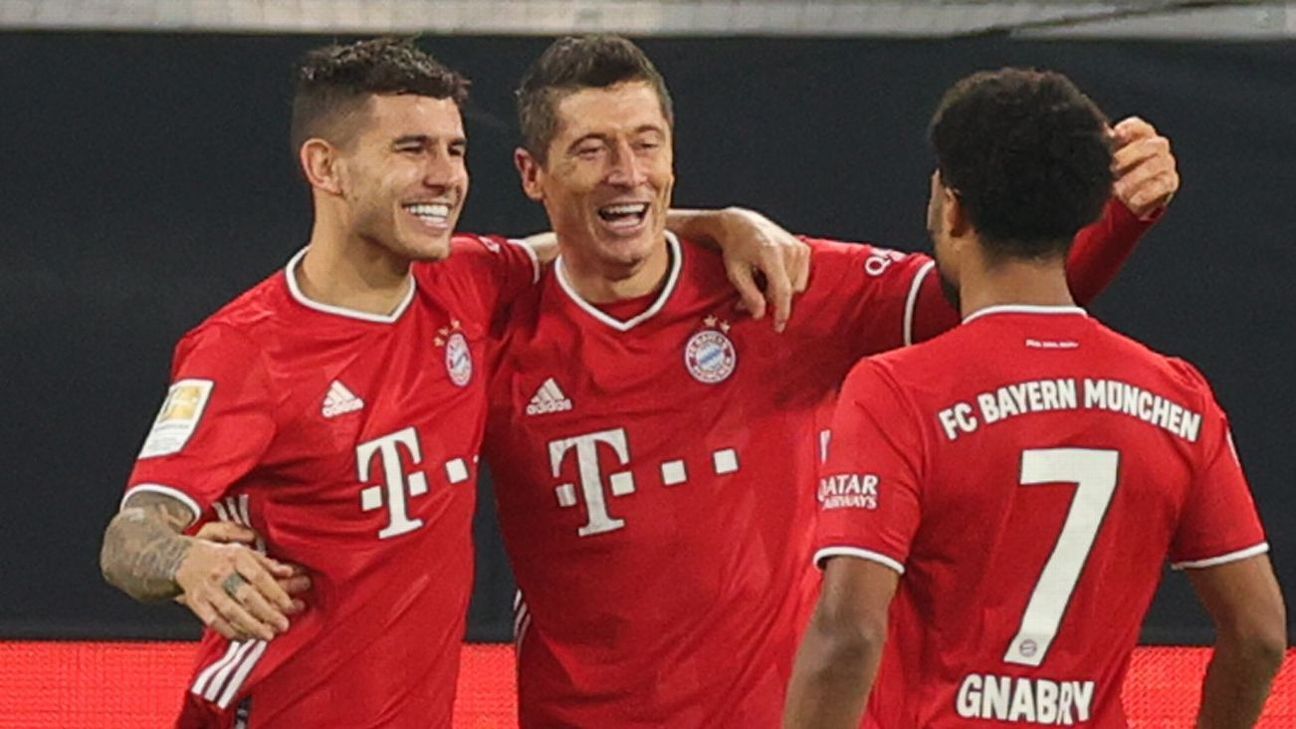The final international break of the season is coming to an end and the European club season is hitting the home stretch. Now’s the time for all the title races (or, more likely, battles for Champions League positions) we’ve been talking about for months to play out. There are plenty of high-consequence matches upcoming.
But beyond important matches or matches with an intense personal rooting interest, we’re coming up on our final few opportunities to watch fun club soccer for a few months. With that in mind, let’s talk watchability. Who are the most enjoyable teams in Europe’s “Big Five” leagues — English Premier League, Spanish Primera Division, German Bundesliga, Italian Serie A and French Ligue 1 — to watch at the moment?
– Stream ESPN FC Daily on ESPN+ (U.S. only)
– ESPN+ viewer’s guide: Bundesliga, Serie A, MLS, FA Cup and more
To address that question, I combined stats and my own aesthetic leanings. Let’s walk through watchability criteria:
-
Quality (6%): It has to matter a little bit, right? If you try to do all the right things but aren’t very good at them, it’s not going to be as watchable. (Relevant category: points per game in league play.)
-
Shots and goals (36%): Traditionalists in every sport will always point out how good defense can be fun, too, and harrumph when things get a little too high-scoring. While I have indeed seen 0-0 matches that I enjoyed immensely … come on. Shots and goals (and the things that create them) are undeniably fun, especially when you are both taking and allowing them. (Relevant categories: goals scored, goals allowed, total average shots, xG per shot and xG per shot allowed, pass completion rate into the attacking third.)
-
Pressure and intensity (25%): A large part of watchability is knowing that the team you’re watching is trying really, really hard. In soccer, that’s reflected frequently in terms of defensive intensity. There aren’t many effective and direct ways of measuring this, but there are a lot of indirect ways, so I’m using quite a few. (Relevant categories: passes allowed per defensive action, opponents’ average passes per possession, possessions beginning in the attacking third and, because watchability goes both ways, opponents’ possessions beginning in the attacking third.)
-
At least a little verticality (9%): In modern soccer, shot quality is often created through patience, building possessions slowly from the back, lots of horizontal passing, etc. But verticality — the ability to explode forward and create occasional fast-break opportunities — is exhilarating. Adding this to the mix rewards teams that create all the shot quality above with a little bit of extra verve. (Relevant category: direct speed, a Stats Perform measure of how many meters a team’s average sequence advances the ball.)
-
Switches and through-balls (2%): I just enjoy them! (Relevant categories: switches of play and through-ball attempts per match.)
-
Tension (7%): If you are up or down by a few goals, and the match is effectively over, things get pretty unwatchable pretty quickly, right? (Relevant category: percentage of a team’s matches that take place with the score within one goal.)
-
Entertaining big matches (15%): In six matches with Liverpool, Manchester United and Tottenham Hotspur, Chelsea have scored and allowed two goals each. United have played in scoreless draws with Chelsea (twice), Liverpool and Manchester City. Even Bayern Munich and RB Leipzig played in a scoreless draw last February. Big matches against intense, possession-heavy teams often produce cautious stalemates, especially in the Premier League. So let’s reward the teams that figure out how to avoid that. (Relevant measures: goals scored and total goals in matches against teams averaging at least 1.5 points per game in league play — the better teams in the league.)
Based on all the above categories, weighted to my whims, I graded every team in Europe’s Big Five leagues on a 0 to 10 scale of watchability. Here are the irrefutably scientific results.
Do not watch unless you have a rooting interest (Grade: 0-1)
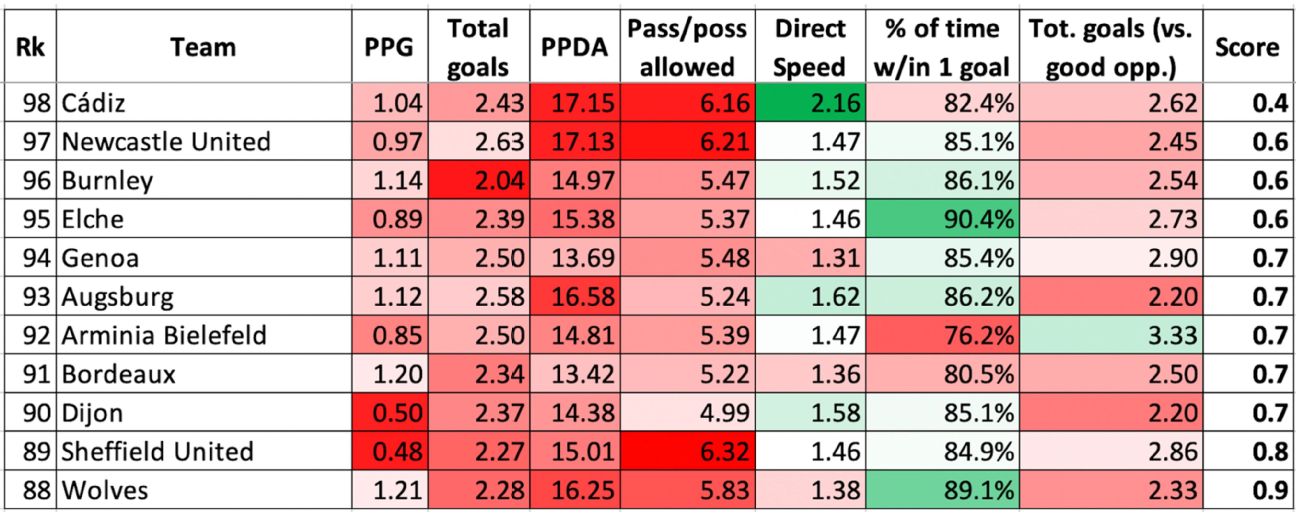
98. Cadiz (0.4)
97. Newcastle United (0.6)
I’m not going to say I calibrated this to make sure that Newcastle graded out as the least-watchable Premier League team… but I’m not going to say I didn’t, either.
96. Burnley (0.6)
95. Elche (0.6)
94. Genoa (0.7)
93. FC Augsburg (0.7)
Augsburg can put together some pretty counterattacks at times, but they aren’t much for defensive intensity and those counters come amid long stretches with no shots.
92. Arminia Bielefeld (0.7)
91. Bordeaux (0.7)
90. Dijon (0.7)
89. Sheffield United (0.8)
88. Wolverhampton Wanderers (0.9)
Wolves do occasionally string together some pretty passing in attacking areas and are constantly involved in close games, but that’s offset by a complete and total lack of defensive pressure, verticality or, in many instances, goals.
At least it’s soccer on TV, right? (Grade: 1-3)
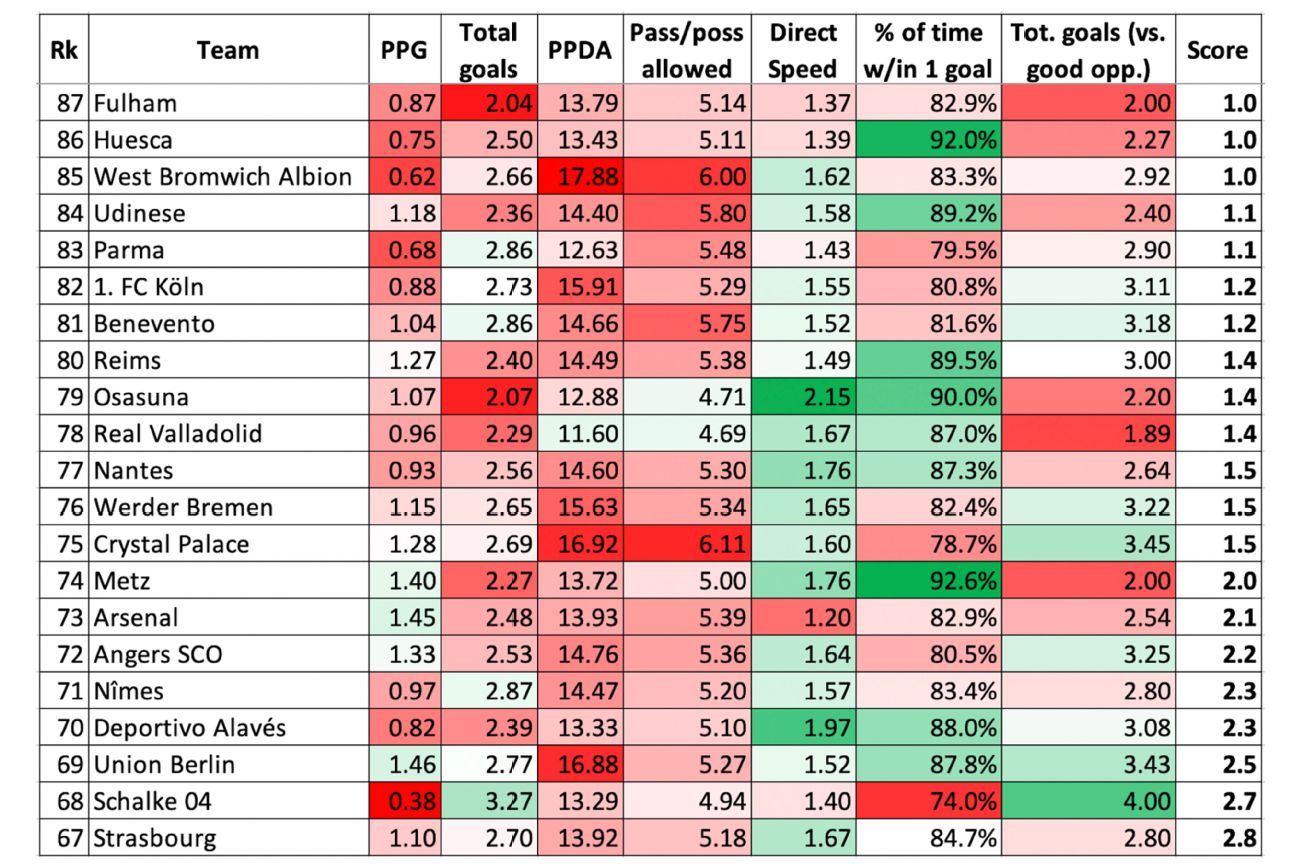
87. Fulham (1.0)
86. Huesca (1.0)
85. West Bromwich Albion (1.0)
84. Udinese (1.1)
83. Parma (1.1)
82. FC Cologne (1.2)
81. Benevento (1.2)
80. Stade de Reims (1.4)
79. Osasuna (1.4)
You have to give Jagoba Arrasate’s squad this: it knows itself very well. Los Rojillos might be the most direct team in Europe, with an average direct speed of 2.2, the highest in the Big Five along with Cadiz. They score points for both that and the fact that 90% of their possessions happen with the scoring margin within one goal. They lose points for, well, everything else. They neither score nor allow many goals, and that’s doubly true when they’re playing a big opponent.
78. Real Valladolid (1.4)
77. Nantes (1.5)
76. Werder Bremen (1.5)
75. Crystal Palace (1.5)
74. Metz (2.0)
73. Arsenal (2.1)
Arsenal this season are basically a slightly better, slightly more watchable Wolves.
72. Angers (2.2)
71. Nimes (2.3)
70. Alaves (2.3)
69. FC Union Berlin (2.5)
68. Schalke 04 (2.7)
Are Schalke maybe the worst team in the Big Five? Yes. But for better or worse, a Schalke match is going to feature shots, goals and possessions starting in dangerous areas. It might just be that their opponents are the ones doing most of that.
67. Strasbourg (2.8)
Could be great fun, could be awful (Grade: 3-6)

66. Everton (3.0)
65. Getafe (3.0)
64. Villarreal (3.2)
63. SC Freiburg (3.3)
62. Marseille (3.3)
61. Tottenham Hotspur (3.3)
60. Cagliari (3.4)
59. Hertha Berlin (3.7)
58. Lille (3.9)
The first true league contender to show up on the list. Lille average more than two goals per match thanks to a lovely attack featuring Burak Yilmaz, Canada‘s Jonathan David and, off the bench, the United States‘ Timothy Weah. But their defense is strong enough to keep scores low, neither they nor their opponents produce consistent shot quality or disruption, and in big matches they are more than happy to keep things sterile — they played Paris Saint-Germain to a 0-0 draw in December, and they somehow did the same with a prolific AS Monaco in mid-March.
57. Sampdoria (4.2)
56. West Ham United (4.3)
55. Granada (4.6)
54. Chelsea (4.8)
Since hiring Thomas Tuchel in late January, the Blues have improved immensely while becoming increasingly unwatchable. In their past 10 league matches, they’ve scored just 10 goals … and allowed only two. Good? Absolutely. Fun to watch? Absolutely not.
53. Brest (4.8)
52. Stade Rennes (4.9)
51. Brighton & Hove Albion (4.9)
50. Crotone (5.1)
49. Nice (5.2)
48. Saint-Etienne (5.5)
47. Bayer Leverkusen (5.6)
46. Fiorentina (5.6)
45. Atletico Madrid (5.6)
Diego Simeone’s Atletico have made unwatchability their brand through the years. They’re going to grind you to dust defensively and eventually hit you on the counter. They’ve had their watchable moments this season, however, averaging 1.8 goals per match and putting together some truly pretty attacking moments (but not that many). That extra oomph in attack has given them the La Liga lead heading into the home stretch.
44. VfL Wolfsburg (5.9)
The potential for enjoyment is pretty good (Grade: 6-8)
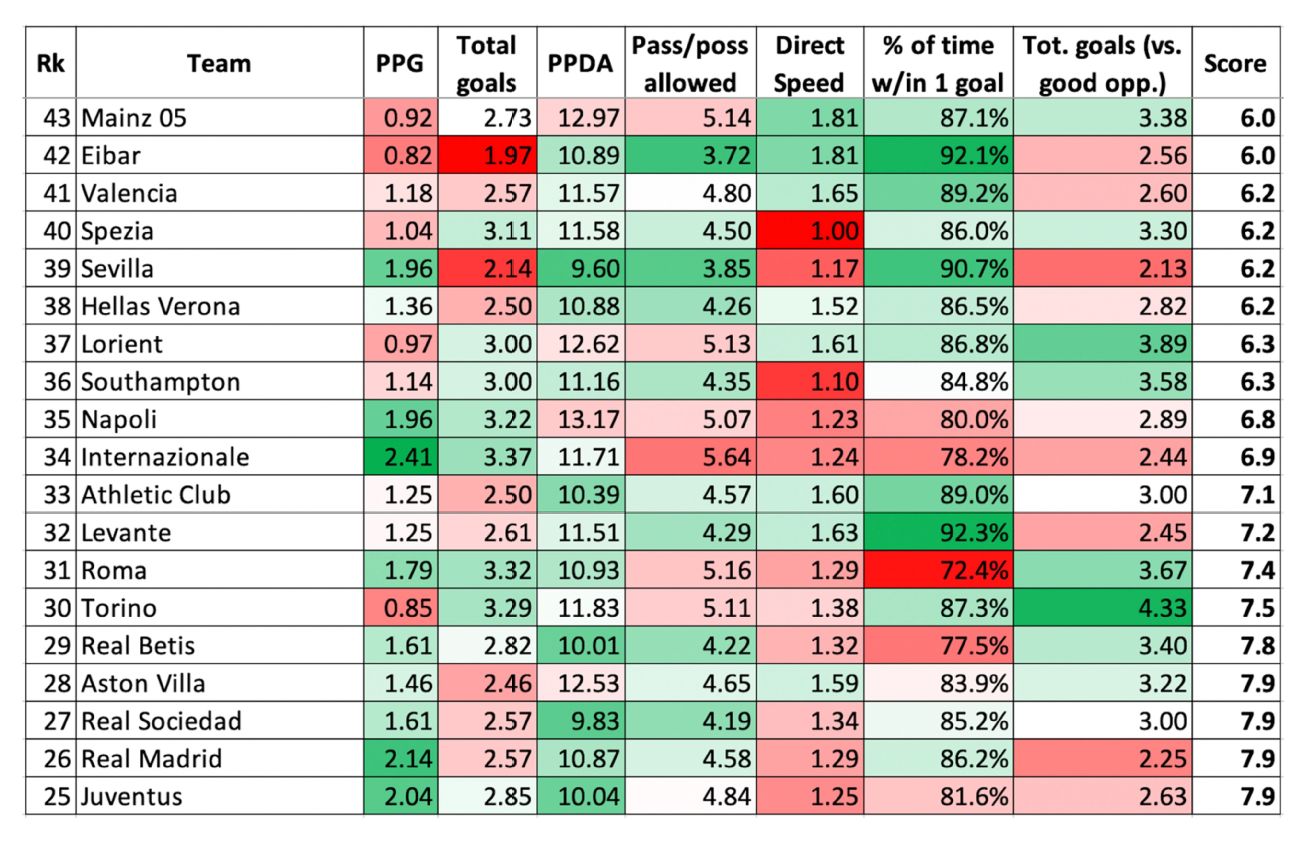
43. Mainz (6.0)
42. Eibar (6.0)
41. Valencia (6.2)
40. Spezia (6.2)
39. Sevilla FC (6.2)
38. Hellas Verona (6.2)
37. Lorient (6.3)
36. Southampton (6.3)
35. Napoli (6.8)
34. Internazionale (6.9)
Inter are plowing toward their first Scudetto in 11 years. They take loads of high-quality shots, pass the ball well and at least selectively apply solid defensive pressure. The biggest factor in only ranking 34th? They are one of the least-vertically minded teams in Europe, and when the chips are down and a big match is underway, they are, like Lille, more than happy to play “lowest-common-denominator ball.” For the season, their matches average 3.4 combined goals, but in matches against good teams, that average sinks to 2.4. It’s worked out well for them, but again, this list is about entertainment.
33. Athletic Bilbao (7.1)
32. Levante (7.2)
31. AS Roma (7.4)
30. Torino (7.5)
29. Real Betis (7.8)
28. Aston Villa (7.9)
Dean Smith’s squad has slipped a bit since a fast start, but they’re still only six points outside of the top six and still have plenty to play for, especially with star Jack Grealish back from injury. They also play in some of the most free-shooting matches in Europe. Villa matches average 27 shots, eighth-most in the Big Five leagues, and while not all of those shots are particularly high quality, there is plenty of both aggression and verticality in a Vlila match.
27. Real Sociedad (7.9)
26. Real Madrid (7.9)
25. Juventus (7.9)
Juve fell in the Champions League round of 16, and their odds of continuing their nearly decade-long Serie A title streak are dim, but in Andrea Pirlo’s first year as manager, as a youth movement slowly makes headway, there have been glimpses of truly fun and beautiful soccer. There have also been just enough defensive glitches to make their matches particularly enjoyable.
You’re going to have a good time (Grade: 8-9)
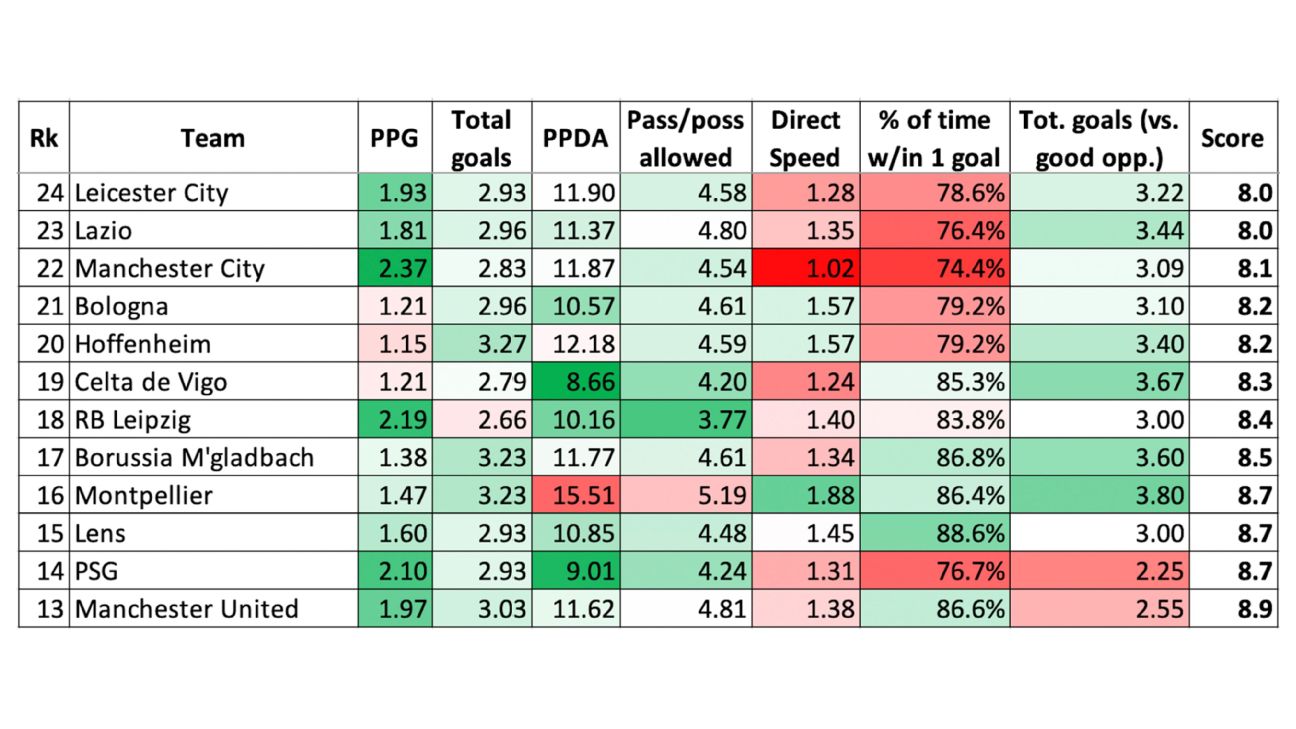
24. Leicester City (8.0)
23. Lazio (8.0)
22. Manchester City (8.1)
The Cityzens score more than almost anyone, they put together beautiful strings of passes and when they play against good teams, the goal scoring actually picks up — their matches average 2.8 goals overall in Premier League play, but matches against particularly good teams average 3.1. These are all good things, but you can probably piece together what’s holding them back from a watchability standpoint: their matches aren’t particularly close and there is, by design, almost no verticality to their attack.
21. Bologna (8.2)
20. TSG Hoffenheim (8.2)
19. Celta Vigo (8.3)
In the Big Five, no team better combines high levels of watchability with aggressively mediocre play (they are 11th in La Liga, averaging 1.2 points per match) than Eduardo Coudet’s Celestes. They allow just 4.2 passes per opponent possession, and their 8.7 PPDA (passes allowed per defensive action) is the lowest in these leagues, too. They attempt a healthy number of through-balls, and when they play good teams, they don’t change a damn thing about what they do. Granted, that doesn’t work out very well for them — in nine matches against La Liga teams averaging 1.5 points per game or more, they have generated only one point and have been outscored, 26-7 — but it’s great for observers!
18. RB Leipzig (8.4)
17. Borussia Monchengladbach (8.5)
16. Montpellier (8.7)
Shots? Montpellier matches average nearly 27 of them. Verticality? Their direct speed is easily the highest in France. Wide-open matches against good teams? Said matches average 3.8 goals. La Paillade swept Lyon and are just four points out of a European slot in Ligue 1, and they have gotten there with fun, optimistic play. They’d rank even higher if they occasionally attempted to apply some defensive aggression.
15. Lens (8.7)
14. Paris Saint-Germain (8.7)
13. Manchester United (8.9)
United have been two completely different teams this year. One is an extremely sound, prolific squad capable of incisive passing, high-level goal scoring, lots of switches of play and decent defensive pressure. The other is the team that plays to 0-0 draws against every good team. Of course, even the latter team has had its expansive moments — a 2-1 win over PSG and a 5-0 win over RB Leipzig in Champions League play, 3-2 against Liverpool in the FA Cup, 2-0 against Man City. This is an extremely watchable team for the most part; just skip future matches vs. Chelsea.
Clear room in your schedule to always watch (Grade: 9-10)

12. AS Monaco (9.0)
Niko Kovac’s loss was our gain; after getting sacked by Bayern Munich in November 2019, he landed at Monaco and has transformed the team into something incredibly enjoyable. They’ve increased their output from 1.6 to 2.0 goals per match and scored 30 in an 11-match span earlier this calendar year. They are safely in fourth in Ligue 1, but they’re also only one point out of third place and a Champions League position.
11. Eintracht Frankfurt (9.0)
I had Eintracht pegged as a candidate for a run at Europe in the preseason, and that pick’s looking solid at the moment thanks to an attack featuring some of the most high-quality shots in Europe — and with former Eintracht star Luka Jovic back on loan from Real Madrid in January — and strong defensive pressure. The occasional defensive breakdown works in our favor, too.
10. VfB Stuttgart (9.1)
The freshly promoted Schwaben are perhaps the quintessential German team this year, producing loads of shots, intermittent pressure and occasionally hypnotic counterattacking. They hang big totals against bad teams (five vs. Schalke, four vs. Augsburg) and occasionally get run out of the building against good ones (0-4 vs. Bayern, 2-5 vs. Leverkusen). You’re getting goals one way or the other.
9. Sassuolo (9.2)
They haven’t kept up in the race for one of Serie A’s European slots, but Roberto De Zerbi’s Neroverdi take and allow a pickup game’s worth of shots, and they pressure the ball as well as anyone in the league not named Juve. They’re the perfect mid-table team, too: good enough to play close games against the top teams and the bottom teams. Can’t beat tension and large goal totals.
8. Liverpool (9.3)
It was bad news for Liverpool and their fans when seemingly every possible central defender on the roster (Virgil van Dijk, Joe Gomez, Joel Matip, even stand-ins Jordan Henderson and Fabinho) got hurt, but from a watchability standpoint, the injuries and added vulnerability made the Reds even more fascinating. They still possess most of the defensive intensity you expect to see from a Jurgen Klopp squad, but frailties at the back have helped to create high shot quality for opponents and a lot more close matches than we perhaps expected. They probably won’t get any less interesting as they attempt a late-year move back up the table, either.
7. AC Milan (9.4)
Milan’s dreams of a first Scudetto since 2011 have faded — Inter are six points up with a game in hand — but this is still their best team in a while, and it’s a sexy team at that. They take lots of high-quality shots, they pressure with youthful vigor (a lot of their minutes to go players 24 and younger) and they occasionally give up lots of shots too. Serie A is, as a whole, so much more watchable than its old reputation, and Milan’s a big reason for that.
6. Leeds United (9.5)
It was easy to assume fun things from a Marcelo Bielsa team in the Premier League, and Leeds haven’t disappointed. They both take and allow lots of shots, they allow only 3.4 passes per opponent possession — fewest in the Big Five — and they are always trying to throw haymakers even if they occasionally get knocked out in the process. They are neither fighting for a spot in Europe nor fighting to avoid relegation, but Leeds matches will remain must-watches all the same.
5. Borussia Dortmund (9.6)
They still have Erling Haaland and Jadon Sancho (and Giovanni Reyna, and Marco Reus, and Jude Bellingham, and …), so of course they’re entertaining. And in 2020-21, they’ve added bonus points for falling behind early in seemingly every single match and therefore producing plenty of tense finishes.
4. Lyon (9.6)
Can you out-PSG PSG for the Ligue 1 title? Lyon are possession-heavy and put together prettier attacks than anyone else in France. They attempt a decent number of through-balls, which wins me over, and they keep the accelerator on, for better or worse, against good teams. Even with a 4-2 loss to PSG on March 21 (like I said, accelerator on!), they’re still only three points back of the reigning champs, which could mean you want to watch Lyon matches both for their aesthetics and their importance.
3. Barcelona (9.6)
As with Liverpool, an extra layer of vulnerability has made Barca incredibly fun to watch all year. They have alternated between a team capable of outright dominance — case in point: their 6-1 domination of Real Sociedad on March 21 — and a team capable of losing four early matches and drawing with teams like Cadiz and Alaves. But they’re fun and prolific and still produce some sexy ball movement. Eminently watchable.
2. Atalanta (9.7)
This isn’t necessarily news anymore, but Atalanta continue to play the most aggressively optimistic soccer in the Big Five. They pressure you, they attempt a ton of shots (and allow quite a few, too), they advance the ball vertically in a way that most of the richest clubs do not. They remain a treat for the eyes, and they are in decent position to qualify for the Champions League once more this year. Here’s to hoping manager Gian Piero Gasperini never leaves, and here’s to hoping he never changes.
1. Bayern Munich (9.8)
When you read the criteria up top, you had to figure the reigning European champions would grade out well. No-one scores more, almost no-one pressures the ball more or allows fewer possessions, and no-one is more capable of coaxing good teams into a track meet instead of a 0-0 standstill. And in 2020-21, they’ve even had an added bonus: their defense has been pretty glitchy. Bayern matches average 4.4 goals this season; no one else in the Big Five tops 3.6. Even if Bayern will likely pull ahead and win eventually, you are going to see fireworks in the process, and no matches are more watchable.
